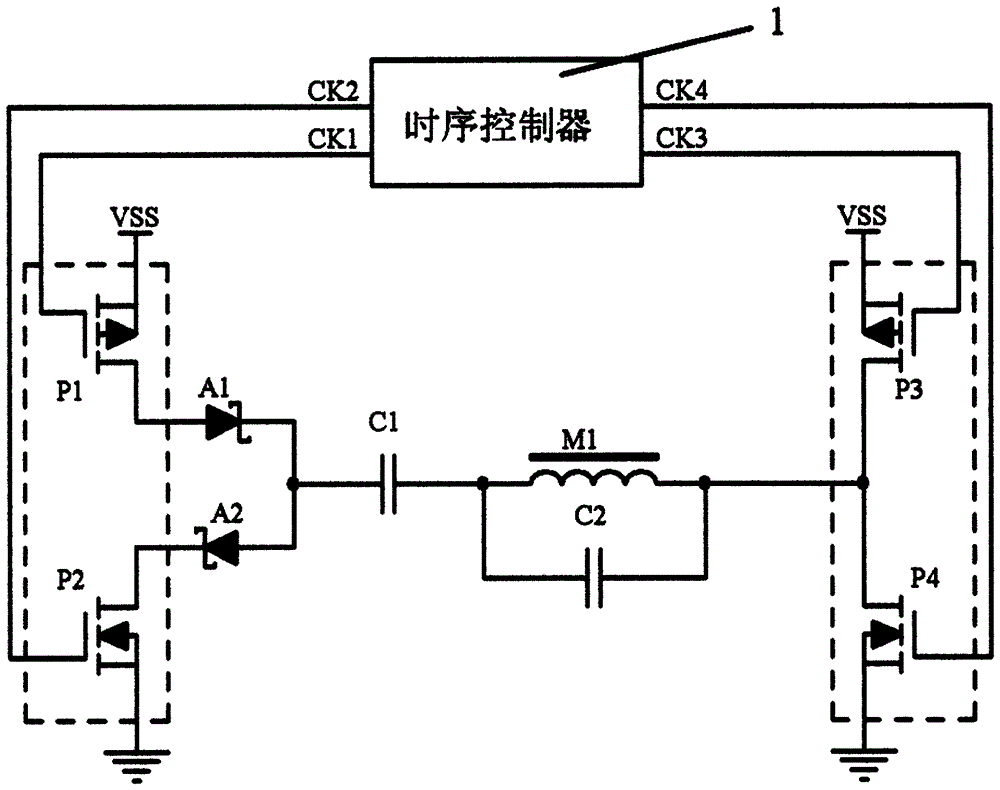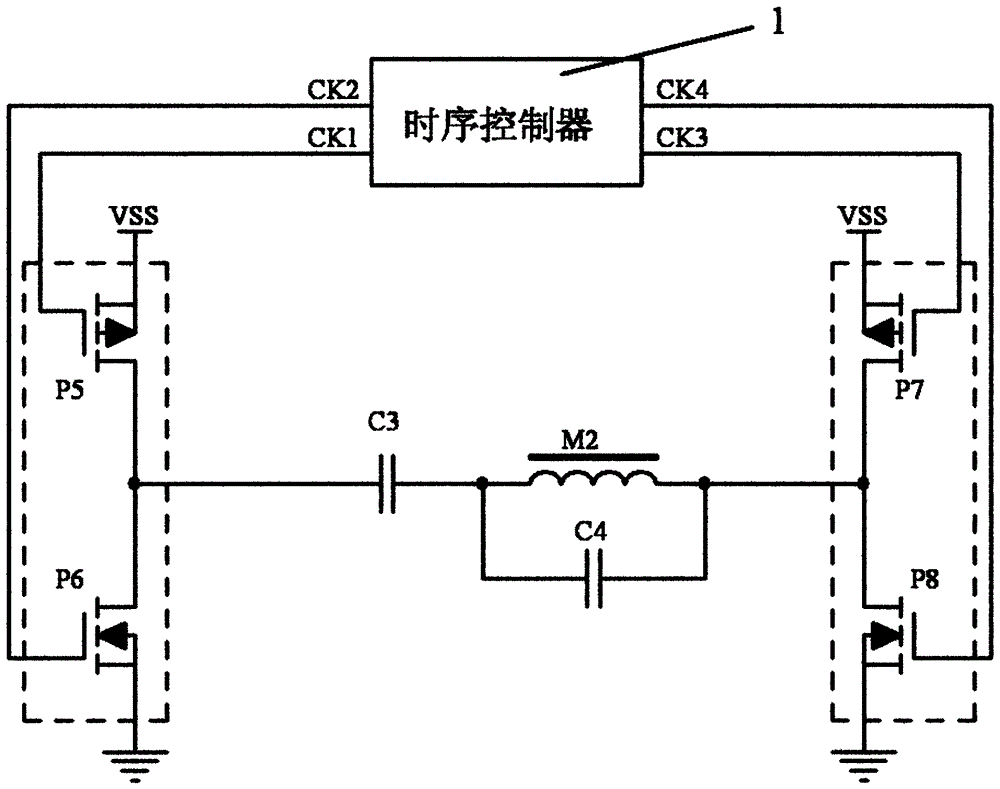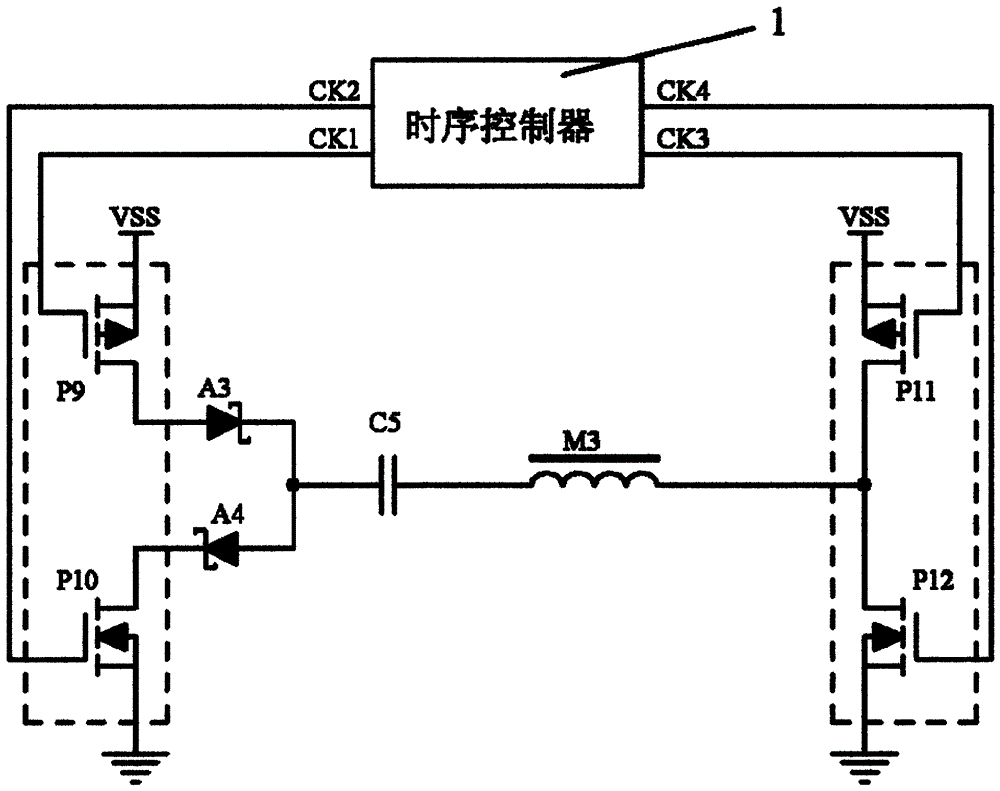A pulse excitation circuit of a DC and low frequency magnetic signal testing device
A test device, pulse excitation technology, applied in the direction of the magnitude/direction of the magnetic field, magnetic field measurement using the principle of magnetic flux control, electrical components, etc., can solve the problem that the excitation power consumption is difficult to further reduce
- Summary
- Abstract
- Description
- Claims
- Application Information
AI Technical Summary
Problems solved by technology
Method used
Image
Examples
Embodiment 1
[0055] Parallel capacitive excitation circuit scheme with unidirectional components: such as figure 1 , the CK1 terminal of the timing controller is connected to the gate of the transistor P1 in the first half-bridge unit, the CK2 terminal of the timing controller is connected to the gate of the transistor P2 in the first half-bridge unit, and the CK3 terminal of the timing controller is connected to the second The gate of the transistor P3 in the half-bridge unit, the CK4 terminal of the timing controller is connected to the gate of the transistor P4 in the second half-bridge unit, and the drains of the transistor P1 and the transistor P2 are respectively connected to the first unidirectional element A1 and the second The unidirectional element A2, the joint point of the first unidirectional element A1 and the second unidirectional element A2 is connected to the capacitor C1, the capacitor C1 is connected to the magnetic probe excitation coil M1, and the magnetic probe excitat...
Embodiment 2
[0067] Parallel capacitive excitation circuit solution without unidirectional elements: In Embodiment 1, the first unidirectional element A1 and the second unidirectional element A2 are removed to obtain this embodiment. like figure 2 , the CK1 terminal of the timing controller is connected to the gate of the transistor P5 in the first half-bridge unit, the CK2 terminal of the timing controller is connected to the gate of the transistor P6 in the first half-bridge unit, and the CK3 terminal of the timing controller is connected to the second The gate of the transistor P7 in the half-bridge unit, the CK4 terminal of the timing controller is connected to the gate of the transistor P8 in the second half-bridge unit, the joint point of the drains of the transistor P5 and the transistor P6 is connected to the capacitor C3, and the capacitor C3 is connected to the magnetic probe The excitation coil M2, the magnetic probe excitation coil M2 is connected to the drain junction of the ...
Embodiment 3
[0076] This embodiment is obtained by removing the capacitor C2 in Embodiment 1. like image 3 , series capacitor excitation circuit: the CK1 terminal of the timing controller 1 is connected to the gate of the transistor P9 in the first half-bridge unit, and the CK2 terminal of the timing controller 1 is connected to the gate of the transistor P10 in the first half-bridge unit, timing control The CK3 terminal of the controller 1 is connected to the gate of the transistor P11 in the second half-bridge unit, the CK4 terminal of the timing controller 1 is connected to the gate of the transistor P12 in the second half-bridge unit, and the drains of the transistor P9 and the transistor P10 are respectively connected to The third unidirectional element A3 and the fourth unidirectional element A4, the joint point of the third unidirectional element A3 and the fourth unidirectional element A4 is connected to the capacitor C5, the capacitor C5 is connected to the magnetic probe excitat...
PUM
 Login to View More
Login to View More Abstract
Description
Claims
Application Information
 Login to View More
Login to View More - R&D
- Intellectual Property
- Life Sciences
- Materials
- Tech Scout
- Unparalleled Data Quality
- Higher Quality Content
- 60% Fewer Hallucinations
Browse by: Latest US Patents, China's latest patents, Technical Efficacy Thesaurus, Application Domain, Technology Topic, Popular Technical Reports.
© 2025 PatSnap. All rights reserved.Legal|Privacy policy|Modern Slavery Act Transparency Statement|Sitemap|About US| Contact US: help@patsnap.com



